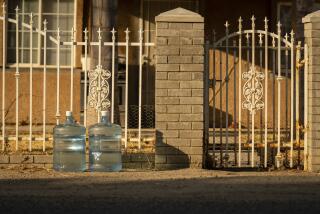New Water Rate Plan Offers Little Relief for Residents : The proposed changes would help businesses at the expense of the homeowner. A Proposition 13 approach is needed, offering discounts for those who have lived here the longest.
- Share via
The Valley water rate crisis is rapidly coming to a head. The mayor’s blue ribbon committee on water rates has revisited the issue and now recommends a revised rate structure taking into account lot size, temperature and household size.
But the new plan promises little relief for Valley water users, some of whom pay almost as much for water as for the mortgage on their house. The proposed rate change will give Valley residents only minimal relief from high water bills.
Meanwhile, the Anheuser-Busch Brewery has announced plans for a $175-million plant expansion that promises no new jobs for the Valley. The DWP has assured the brewery that it can have all the water it wants, because without water there is no beer. To make matters worse, the state Water Resources Control Board is demanding that L. A. sharply reduce the amount of water drawn from Mono Lake.
In Mayor Richard Riordan’s business-at-any-price climate, there is plenty of water for breweries, but the tap is turned off for Valley residential water users. They are promised only nominal rate adjustments for lot size and location. Under the new scheme, Valley water users are still being treated unfairly.
For example, a resident in Sherman Oaks with a 10,000-square-foot lot will be in a “moderate” zone and allowed 25 billing units at the low rate during the summer. An Encino resident with a similar lot only a few blocks away will be in a “hot” zone, and allocated 26 billing units. Those living in the “cooler” areas are allotted 23 billing units. In other words, those in the hot zone will get only 13% more water at the low rate than those in the coolest.
The stingy allotment of billing units does not adequately deal with certain facts. First, the Valley is significantly hotter throughout the year than the rest of the city, so water consumption is higher. Second, many Valley lots are large and often include fire-prone hillsides. This means more water is necessary for a household because of irrigation and fire prevention requirements.
*
To correct the problem, Valley residents should be given substantially larger breaks on water rates because of our climate, average lot size and fire prevention needs. The two-tier system needs to be reworked to shift a greater burden of water system costs to new or expanded developments. It is new projects, such as the Anheuser-Busch expansion, that are driving up water prices for everyone else.
The water rate committee should take a Proposition 13 approach to water rates. Water should be priced so that established residents pay a lower price than new customers. Substantially higher prices should be charged to new users.
The committee should recommend that new users on the system be charged the marginal (incremental) cost per 100 gallons of water, not the average or base-line cost. The marginal cost of water is what the DWP must pay for the next unit of water purchased and is substantially higher than the average cost. As it is now, the DWP distributes the cost of system expansion evenly to all users.
A DWP study reveals that local untreated ground water costs the DWP $90 per acre-foot; Los Angeles Aqueduct water, $100; Metropolitan Water District water, upward of $250; reclaimed water, a hefty $500; desalinated seawater would cost an astounding $5,500. (There are 326,000 gallons in one acre-foot, enough to supply two average-size families for one year.)
There was a time when all of Los Angeles could exist on cheap local underground water. Today, the DWP must draw water from ever more expensive sources. Therefore, the pricing policy should be to charge new users upward of $500 per acre-foot, which more closely reflects the true cost of water. At the same time, existing users, often elderly or low-income, should be charged the lower ground water rate or, at worst, the Los Angeles Aqueduct rate.
*
Rate restructuring should place a heavier burden on commercial-industrial users than residential users. It’s not fair to make residents subsidize voracious enterprises, especially those that do not create jobs.
Another blow to Valley rate payers is the sewer charge tacked onto the water bill. It is fallacious to assume that Valley sewage is proportional to water consumption. In the Valley, a large amount of water is used for irrigation and goes back into the water table, not down the sewer and out to sea. In the rest of the city, because of smaller lot sizes and lessened fire hazard, much of the water winds up in the sewer system. This alone justifies a substantial break on Valley sewage fees.
What is needed is a new approach to pricing water, one that will treat Valley residents fairly while limiting the insatiable demands of selected favored industrial users. The Proposition 13 approach has worked well to control property taxes. It can also work to control water rates.
More to Read
Sign up for Essential California
The most important California stories and recommendations in your inbox every morning.
You may occasionally receive promotional content from the Los Angeles Times.













